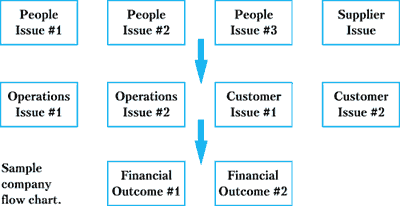Книга: Английский язык. Практический курс для решения бизнес-задач
Назад: Double-Loop Feedback
Дальше: The Payoff: BSC Customer Profitability Metrics
Why Do Executives Love Balanced Scorecard?
The BSC does its magic by focusing the organization on the issues which the leadership team decides are key to its success. It does this through the process of implementing the scorecard – so a human element is the key.
There are other benefits – stronger communication (through the cascading and measurement tracking processes), warning of opportunities ahead (from watching key performance indicators), less «information overload» (from focusing on the most important measures), and greater alignment (from agreement on key objectives).
A sheet of paper with numbers on it can be created by one person and implemented by sheer force of authority. However, the point of a BSC is to:
– Align all members of an organization around common goals and strategies
– Link initiatives to the strategy, making prioritization easier
– Provide feedback to people on key issues – areas where they can have an impact
– Be an essential decision-making tool for everyone in the organization
The best process is to first create a clear business model, and then to select measurements based on that model. This increases commitment, brings more agreement on the direction of the organization, builds accountability to company goals, and increases the speed of change. The first part of the process is creating a model for the scorecard. First, review and clarify strategies. The next step is agreeing on what capabilities are needed within the company to actually pursue the strategy. The final part is creating the actual model. This is where you set up a simple diagram that reflects how you think the business works.
Larger organizations usually adopt a top-down approach: a balanced scorecard is first installed at the top, where commitment is most vital to success. It is then cascaded throughout the organization, to align departments’ goals with the overall company goals. For single stores or small companies, this step might be unnecessary.
The final step is getting people to use the scorecard as a routine matter – making it part of the culture. This is where most management initiatives go wrong, leading to this sage advice: If you want something to be a useful tool, make it the only initiative you try this quarter, give it your full attention, and don’t take any shortcuts. Otherwise, an initiative becomes a fad and eventually appears in the Dilbert cartoons.
Once created, the scorecard should become a part of your business’ daily life; it should be embedded into a company’s operations as a standard decision-making tool. The BSC leverages common sense into a substantial competitive advantage.
Source: www.quickmba.com, www.balancedscorecard.org, Paul Arveson, 1998

Happy customers are good, but profitable customers are much better.
The Balanced Scorecard introduced customer metrics into performance management systems. Scorecards feature all manner of wonderful objectives relating to the customer value proposition and customer outcome metrics – for example, market share, account share, acquisition, satisfaction, and retention.
Yet amid all these measures of customer success, some companies lose sight of the ultimate objective: to make a profit from selling products and services. In their zeal to delight customers, these companies actually lose money with them. They become customer-obsessed rather than customer-focused. When the customer says «jump,» they ask «how high?» They offer additional product features and services, but fail to receive prices that cover the costs for these additional features and services.
How can companies avoid this situation? By adding a metric that summarizes customer profitability.
Consider the situation faced in the 1990s by one of the nation’s largest distributors of medical and surgical supplies. In five years, sales had more than tripled to nearly $3 billion, yet selling, general, and administrative (SG&A) expenses, thought by many to be a fixed cost, had increased even faster than sales; margins had declined by one percentage point and the company had just incurred its first loss in decades.
The experience of this company is hardly unique. Companies often capture additional business by offering more services. The list is wide-ranging: product or service customization; small order quantities; special packaging; expedited and JIT delivery; substantial pre-sales support, etc. While all of these services create value and loyalty among customers, none of them come for free. For a differentiated customer intimacy strategy to succeed, the value created by the differentiation has to exceed the cost of creating and delivering customized features and services.
Unfortunately, many companies cannot accurately decompose their aggregate marketing, technical, service, and administrative costs into the cost of serving individual customers. Either they treat all such costs as fixed-period costs and don’t drive them to the customer level, or they use inaccurate methods, such as allocating a flat percentage of sales revenue to each customer to cover indirect «below-the-line» expenses.
The remedy to this situation is to apply activity-based costing (ABC) to accurately assign an organization’s indirect expenses to customers. Many companies, however, have tried ABC at some time during the past twenty years and abandoned it because it did not capture the complexity of their operations, took too long to implement, and was too expensive to build and maintain. Fortunately, a new approach is now available that is far simpler and much more powerful than traditional ABC.
«Time-driven» ABC requires obtaining information on two parameters: the cost per hour of each group of resources performing work; and the unit times spent on these resources by specific activities for products, services, and customers. For example, if a customer support department has a cost of $70 per hour, and a particular transaction for a customer takes 24 minutes (0.4 hours), the cost of this transaction for this customer is $28. The end result is the ability to measure individual customer profitability accurately and in a system that is easy to implement and inexpensive to maintain and update.

